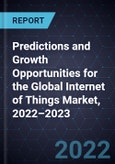The COVID-19 pandemic significantly impacted enterprises’ IoT strategies. As digital transformation came to the forefront, priorities and demand for IoT solutions accelerated. To measure the impact, the publisher updated its IoT market forecast for 2022 to 2023 based on conversations with market participants and results of end-user surveys from late 2021.Companies Resuming Investments and Adopting New Technologies Enable Quick Market Recovery from the Pandemic’s Aftereffects
The total IoT market in 2021 - comprising professional and managed services, hardware, platforms and software, and connectivity services - accounted for $190.26 billion in revenue. In 2021, revenue growth rates indicated a market recovery compared to 2020, when the pandemic hit harder, cancelling or postponing several large IoT projects. Although the rising demand for hardware, platforms, and software for IoT solutions push the market forward, revenue growth rates are forecast to slow down in 2023 (20%) compared to the previous year (28%).
In this study, the publisher provides a revenue forecast of the IoT market with a base year (2021) and a forecast period (2022 to 2023). The technological segmentation of the IoT market considers IoT components: professional and managed services, hardware, platforms and software, and connectivity services. The study also covers a revenue forecast by region: Asia-Pacific (APAC); Europe, the Middle East, and Africa (EMEA); North America (NA); and Latin America (LA). Lastly, the market forecast comprises an IoT connectivity segmentation by technology [machine-to-machine (M2M) (2G, 3G, 4G, and 5G), cellular LPWAN (NB-IoT and LTE-M), and LPWAN (unlicensed)].
We offer stakeholders vital insights on IoT growth opportunities, including multi-access edge computing (MEC), blockchain, cybersecurity, and ambient intelligence (Aml).
Table of Contents
1. Strategic Imperatives
2. Growth Environment
3. End-user Perspectives for IoT (2021-2023)
4. Market Forecasts - Global IoT Market
5. Growth Opportunity Universe








